During my time as a baseball pitcher, I’ve come to understand that success on the mound isn’t just about the ultimate strength. A pitcher must master hard and accurate baseball pitches while adapting to the ever-changing game situations.
So, to be a great pitcher, I’ve learned the essence of different pitches. Knowing the Types of Pitches Baseball, such as fastballs, curveballs, and changeups, is just as important as other skills.
When I was a young pitcher, I remember a particular game I threw only four-seam fastballs. The batters quickly caught on, and I was struck.
It was the moment when I realized mastering different types of pitches was essential to keep my opponents guessing. Some baseball pitches were hard and straight, while others had a softer break, like sliders and curveballs.
As I worked on my skills, I learned to switch between various pitch types, making it increasingly difficult for hitters to predict my next move. This strategy not only led to more swing-and-misses but also limited the batters to soft contact.
Types of Pitches Baseball
A pitcher is a magician. He can do wonderful things just with a baseball in his hand.
He can toss the ball at above 100 miles per hour or at less than 70 miles per hour. He can make it go left or right, up or down. Isn’t it a great scene to watch? Not to the batter! Pun alert.
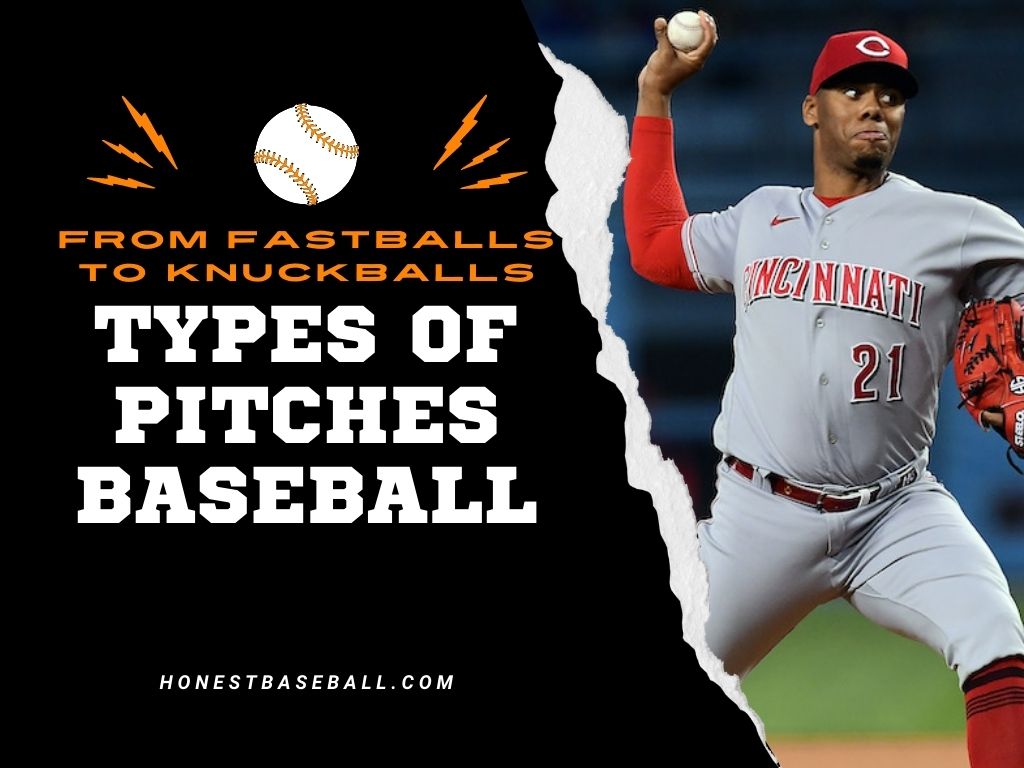
Your skill with different types of pitches is your weapon at the plate. If you master them, you can be lethal to the batter. But your pitching type depends greatly on your focus, concentration, and grip.
By the way, if you’re just starting out and looking for something a bit more beginner-friendly, you might want to check out “Pitching for Beginners in Softball.” It’s a fantastic guide that breaks down the basics and helps newcomers ease into the world of pitching.
Let’s see how many types of pitches there are, how you can identify one, and how you can throw them. I’ll demonstrate them using figures later on.
- Fastball
- Curveball
- Slider
- Changeup
- Knuckleball
- Split-finger fastball
- Sinker
- Screwball
- Cutter
- Palmball
- Forkball
- Gyroball
- Eephus pitch
- Knuckle curve
- Slurve
- Spitball
Fastball
Fastball! Everyone starts practicing with this one.
This one’s easy and the most basic. The standard baseball pitch is a four-seam fastball. It is clear straight, and tough. Since they are, um, fast, they are known as fastballs.
Do you know what’s more difficult? Throwing a fastball that looks like it’s rising in the air. My god, that’s a good one if you throw it right. It will mess with your eyes. I call it an optical illusion, and it will be one of the coolest things you can do with a baseball.
Well, there are different kinds of fastballs. Each type will give you it’s own set of advantages.
Let’s start with the four-seamer. It’s the fastest one, and it can zoom past the batter at 100 mph. The two-seamer is slower, but it moves more, so it’s harder to hit. Then there’s the cutter, like a fastball that suddenly swerves to the side.
And the sinker, which drops down as it reaches the plate. These pitches are great for getting ground balls and strikeouts. To throw any fastball, you need to grip the ball with your fingers on top of the seams.
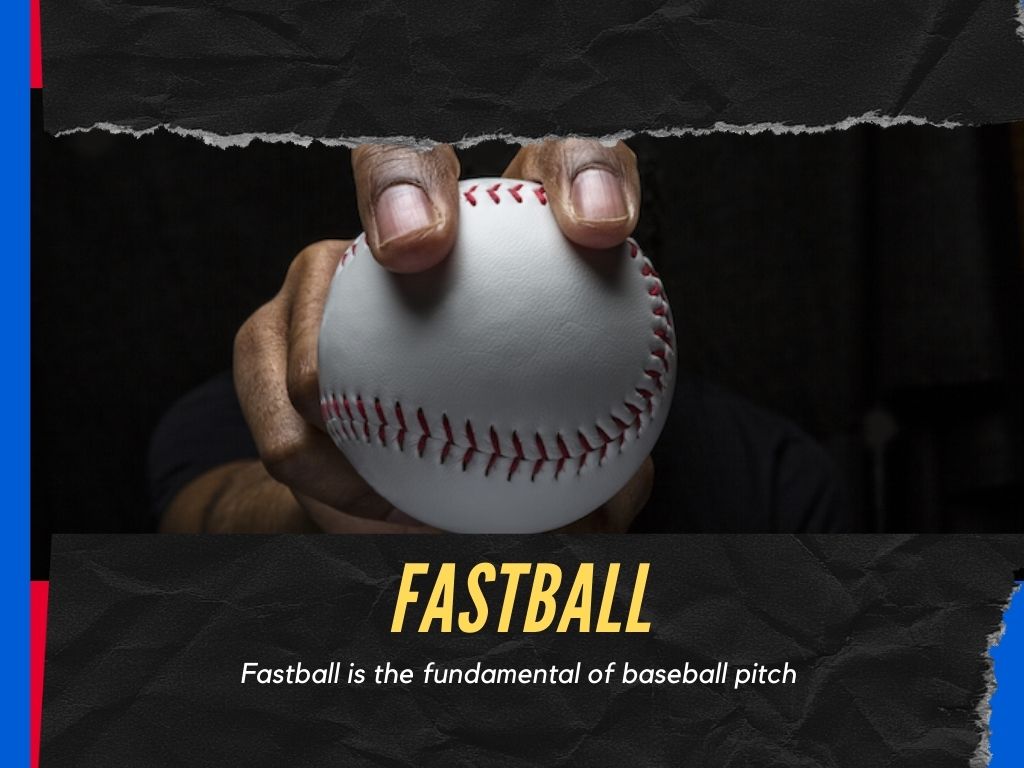
Then you throw it with a straight arm, leading with your elbow. Don’t forget to follow through with your throw—that’s how you get more power and speed.
Fastballs are a good pitch to start with if you’re new to pitching, but they take time and practice to master. You’ll need to learn how to change your speed and movement to keep the batters guessing.
Fastballs have different variations.
- Four-seam fastball
- Two Seam fastball
- Cutter (Cut Fastball)
- Splitter (Split Fastball)
Four-seam Fastball
Four-seam Fastball is your basic pitch, but it’s straight as an arrow. Sometimes it’s so straight it looks like it’s going up.
To throw a fastball, you need to grip the ball with your fingers on top of the seams. This makes the ball spin backward, which helps it fly straight and fast.
That’s why it’s hard for batters to hit it. It’s a common pitch for many pitchers, but it takes a lot of practice to master.
Two-Seam Fastball
Already scratching your head about the two-seam fastball? It’s like a four-seam fastball but with a twist. Literally. Instead of gripping the ball on the seams, you grip it between them.
This makes the ball move more, so it can sink or tail away from the hitter. It’s not as fast as the four-seamer, but it’s harder to hit because of its dancing in the air.
Read More: 2 Seam Vs 4 Seam Fastball
Cutter (Cut Fastball)
Have you heard of the cutter? It’s a type of fastball, but it’s not like the others.
It’s thrown with the same grip as the four-seamer, but with a little twist of the wrist. This makes the ball move sideways and cut away from the hitter’s bat.
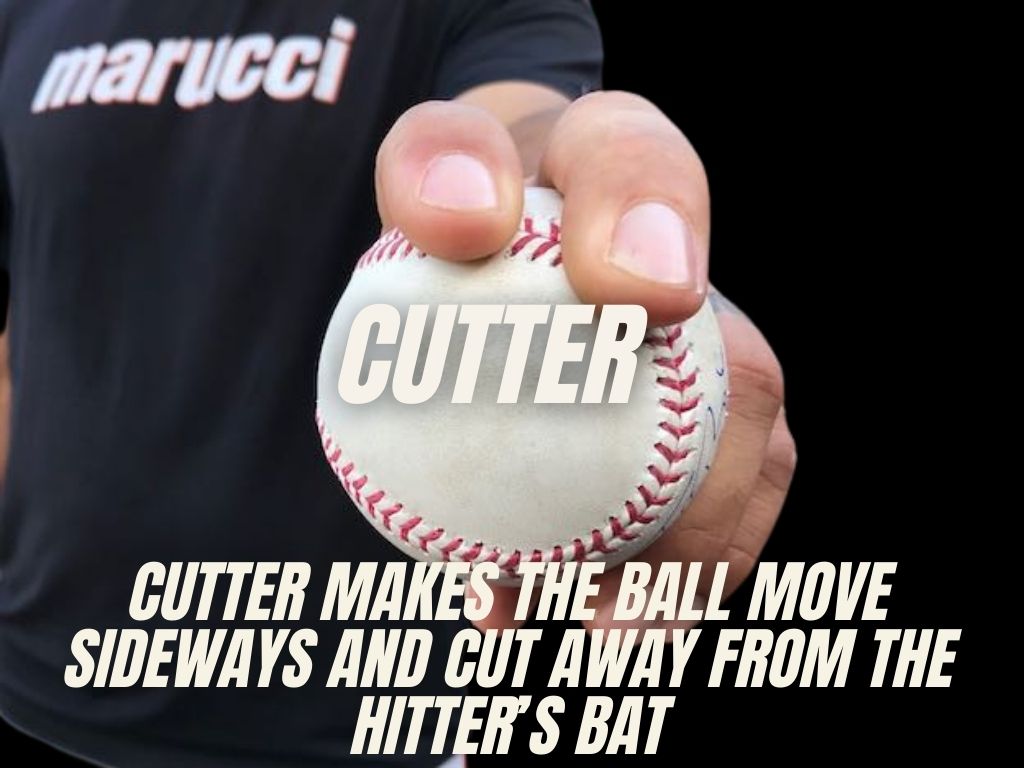
It’s a tough pitch to hit because it moves at the last second, so it’s a favorite pitch for many pitchers.
Splitter (Split Fastball)
A splitter is actually a sneaky way to make a hitter look silly. How?
Well, a splitter looks exactly like a fastball until it suddenly drops like a stone and makes the hitter swing and miss.
How does it work? The secret is in the grip.
You have to spread your fingers wide and squeeze the middle of the ball hard. This makes the ball spin less and dive more as it reaches the plate.
As you explore the fascinating world of baseball pitches, you might also be curious about some specific strategies pitchers use, like the “pitching out” technique. I’ve discussed all the aspects of pitching out here. If you are curious, you might want to check this one out.
Curveball
A curveball is a slick pitch. It bends down and sideways, making batters scratch their heads and lose their balance. It’s one of the most beautiful pitches.
When you see a perfect curveball, you can’t help but admire it. A curveball’s break is big and round. It goes up and then down. You can watch it pop out of the pitcher’s hand and then drop like a stone back to the ground.
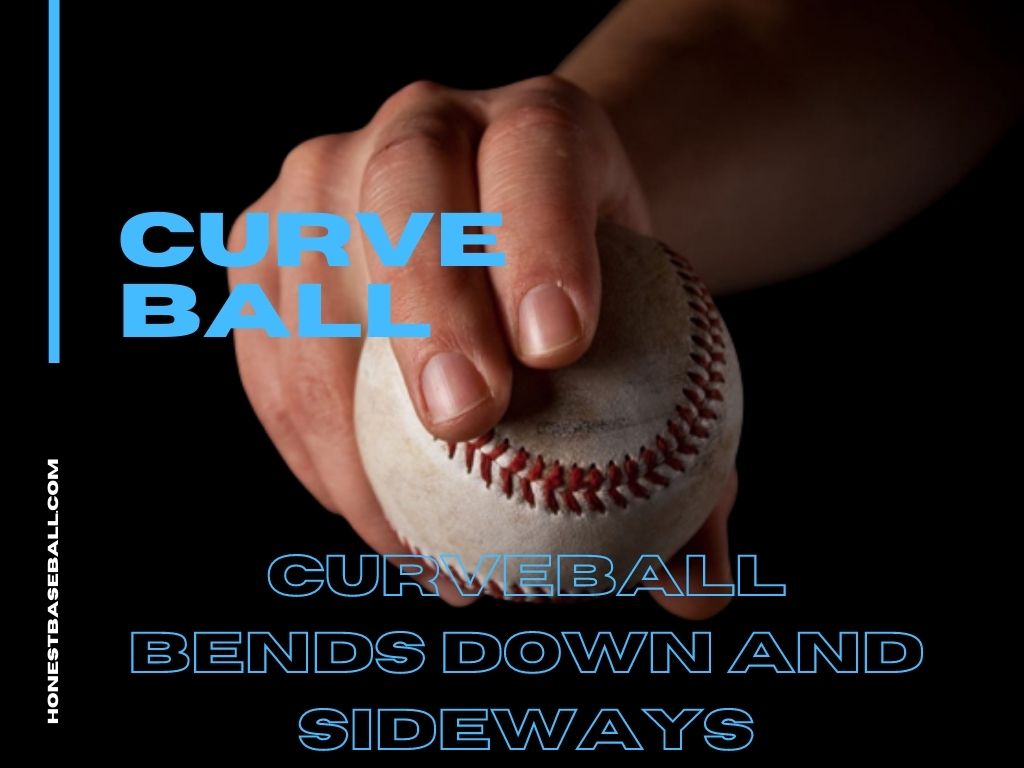
A curveball looks more like a rainbow. To throw a curveball, hold the baseball with your middle finger along the bottom seam and your index finger next to it.
Your thumb should be on the back seam, making a “C” shape. While you release the ball, push it with your middle finger. It will give the ball a spin, which makes a nice curve.
The spin causes the ball to break. The ball moves down and sideways as it progresses toward the batter.
Slider
Let’s talk about the breaking balls – the pitches dance more than they progress.
First up is the slider.
The slider goes sideways, like a cutter – left to right for a righty pitcher, right to the left for a lefty. It has a faster and sharper break than a curveball, with a sneaky little twist at the end that can trick hitters.
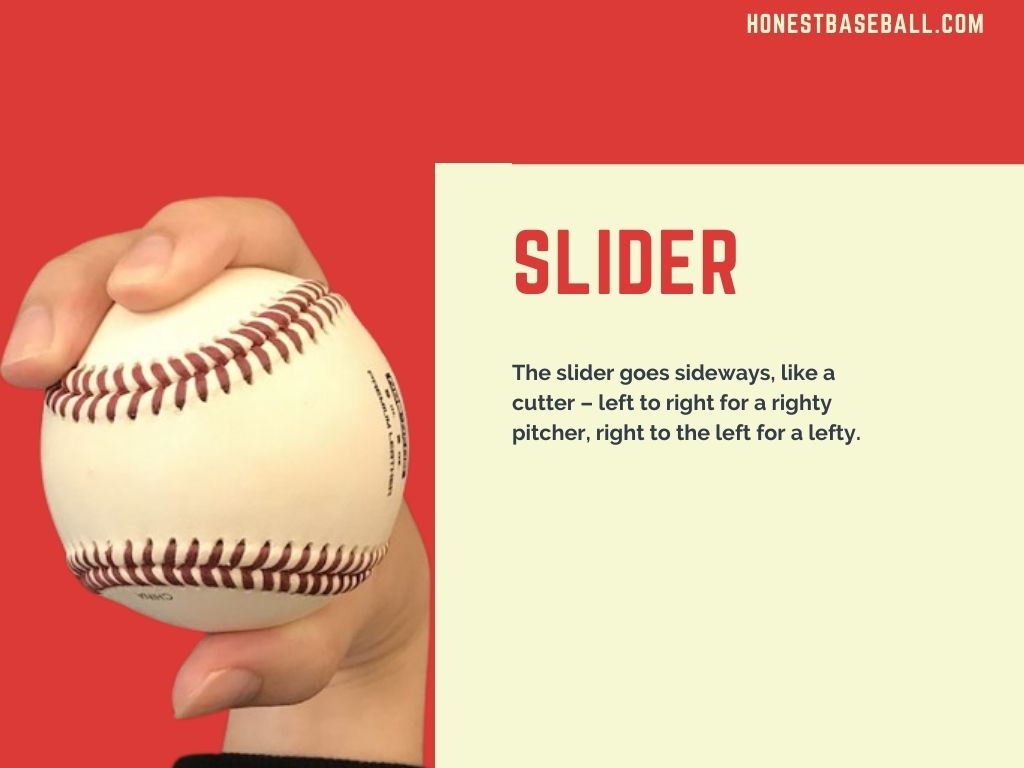
A cutter looks like a fastball and then suddenly turns left or right. What is mesmerizing in the slider? You can see the break fully from start to finish.
To throw a slider, hold the ball with your middle and index fingers on the outer seam, just like the two-seam fastball. Your thumb should be under the ball on the opposite seam.
When you release the ball, push it in the seam with your fingers and twist your wrist. It will give a nice spin to the ball to make an excellent slide. The spin makes the ball move sideways.
Changeup
Do you know how some pitchers throw really fast balls that make the batter swing like crazy? Well, there’s a sneaky trick they can use to mess with the batter’s timing even more.
It’s called a changeup. A changeup looks like a fastball, but it’s actually much slower.
So the batter swings too early and misses the ball. Ouch!
What is the cool thing about a changeup? It can also move sideways or downwards as it moves toward the plate. This makes it even harder to hit it.
Now you may ask, how do I throw this tricky pitch? All you have to do is just grip the ball with your three fingers across the top and the thumb underneath.
This further reduces the friction between your hand and the ball. When you release, the ball comes out slower.
Just make sure you keep your arm speed and motion the same as a fastball so the batter doesn’t suspect anything. That’s how you throw a changeup!
Knuckleball
Have you ever seen a pitch that looks like it defies the laws of physics? A knuckleball exactly does that. In my opinion, it’s one of the most fascinating and difficult pitches to master.
A knuckleball is like no other pitch. Can you believe that it doesn’t need any spin? Rather it lets the air currents take control and create unpredictable and erratic movement.
A knuckleball can be a secret weapon for a pitcher. It can easily fool even the best hitters in your game.
How does knuckleball defy the laws of physics? How can you identify one?
You can identify a knuckleball by its signature wobble as it flies toward the plate. It also moves much slower than other pitches. The ball speed is usually between 60-70 mph.
But don’t let that fool you – a knuckleball can change direction at any moment, making it hard for the batter to time and hit it. Sometimes you don’t have an idea where the ball will go.
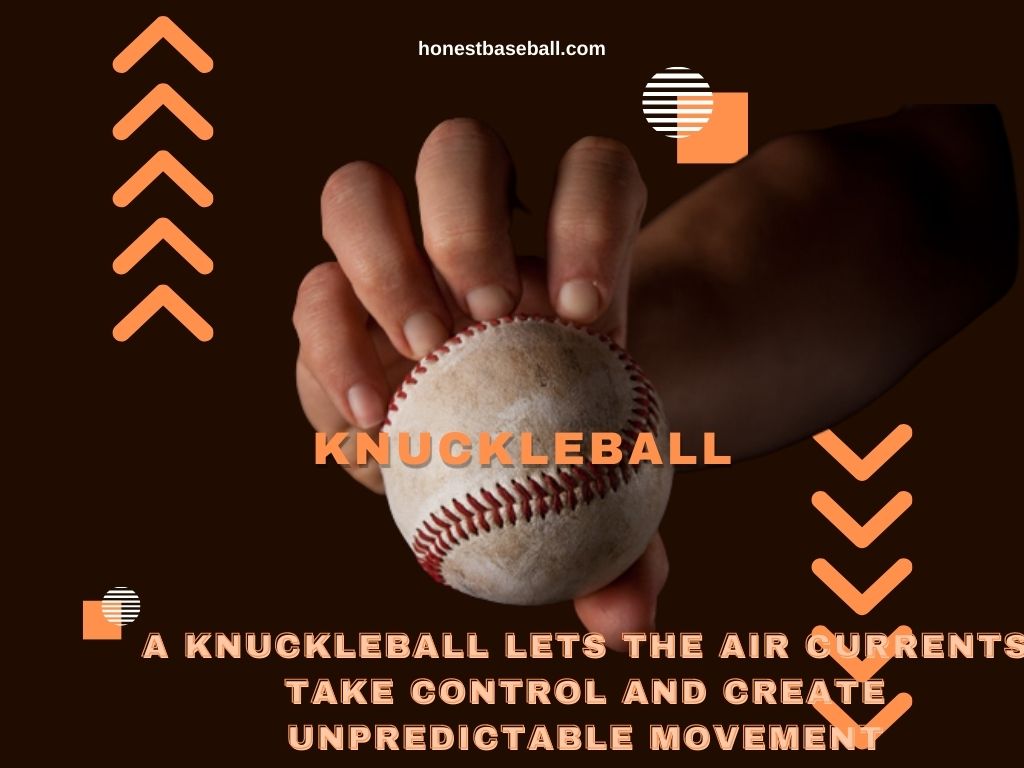
Throwing a knuckleball is also a somewhat tough job. Don’t be discouraged yet.
Grip the ball with your fingertips. Now, dig into the seams with your knuckles or your fingernails.
You also need to keep your wrist stiff and avoid snapping it when you throw. Remember, the ball shouldn’t give any rotation. The way I have told you will help reduce spin on the ball and let it dance in the air.
Keep your pitching motion relaxed and smooth, just like you throw a fastball. You don’t need to put too much force or effort into it. Just let the ball glide out of your hand with minimal spin.
The only thing you have to keep in mind is that you will push the ball rather than flick it with your wrist.
Keep your body balanced and let your arm slow down on its own. Don’t try to stop or jerk your arm right away. It can make the ball rotate, or you can injure your arm.
Split-finger fastball
Imagine a fastball, but with a sharp downward movement as it approaches the plate. That’s a splitter!
It’s more like a deceptive pitch that can be an effective strikeout pitch. The splitter is identified by its sharp, late-breaking downward movement.
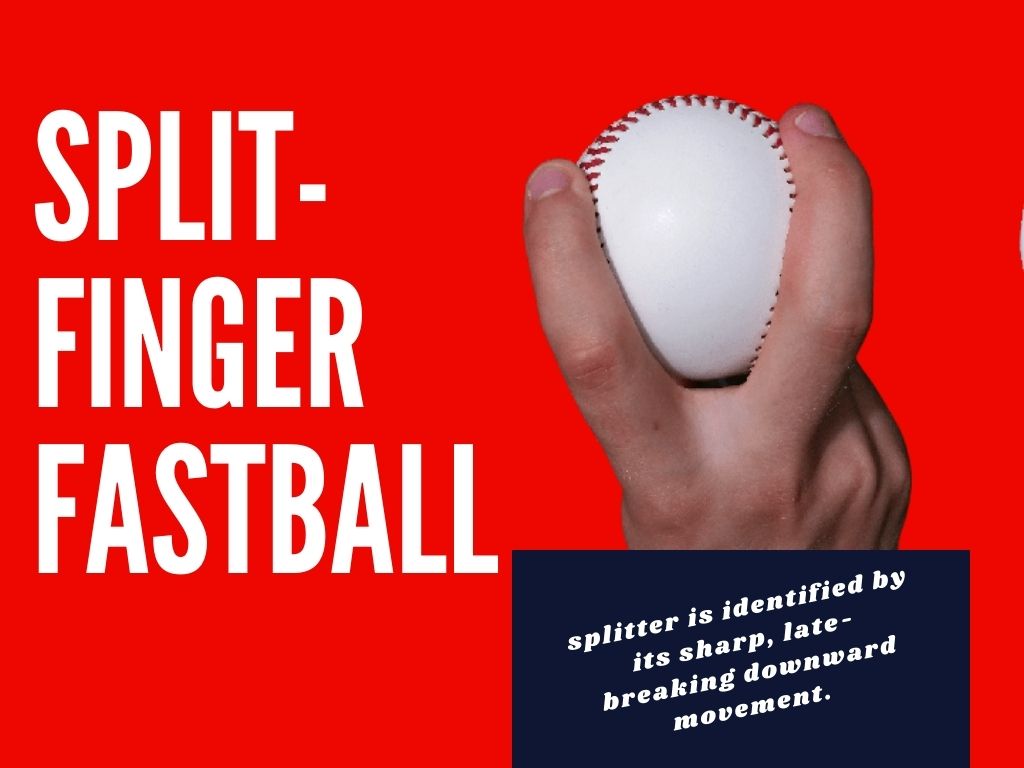
It typically has a similar speed to a fastball, but as it approaches the plate, it appears to drop off the table, making it difficult for batters to make solid contact.
To throw a splitter, place your index and middle fingers on either side of the ball, spread wide apart along the seams. Your thumb should be positioned underneath the ball, providing support and control.
Use the same arm action as you would for a fastball. Keep your arm relaxed and maintain a consistent throwing motion.
As you release the ball, maintain the wide finger position and snap your wrist downward. This will generate the downward movement characteristic of the splitter.
Complete your follow-through as you would with a fastball, ensuring a balanced and controlled finish.
Sinker
Do you want to make batters hit weak grounders? Then you need to learn how to throw a sinker! It’s like a two-seamer but with more drops.
The sinker is a pitch that sinks! It’s like a two-seamer, but it has more vertical drop. It’s a great pitch for ground balls because it’s hard for batters to make solid contact.
It’s a sneaky pitch that moves sideways and down at the same time. It can go as fast as a fastball, but it’s much harder to hit. Here’s how you do it: Grab the ball with your index and middle fingers on the thin seams, like you would for a two-seamer.
To throw a sinker, hold the ball with your index and middle fingers placed along the narrow seams, like a two-seam fastball grip. Your thumb should be positioned underneath the ball, providing support and control.
Maintain the same arm action and windup as you would for a fastball, keep your arm relaxed, and follow a consistent throwing motion. But when you let go of the ball, push down with your index finger and keep your middle finger loose.
That will make the ball spin and move in the air. The ball will go downward and tailing movement characteristic of the sinker. Finish your throw like a fastball, with good balance and control. And that’s how you throw a sinker that will fool any batter!
Screwball
If you want to throw a pitch that will surprise and confuse batters, you should definitely try a screwball.
A screwball is the opposite of a curveball. You might not see this pitch often. But it has the power to make a difference in the plate.
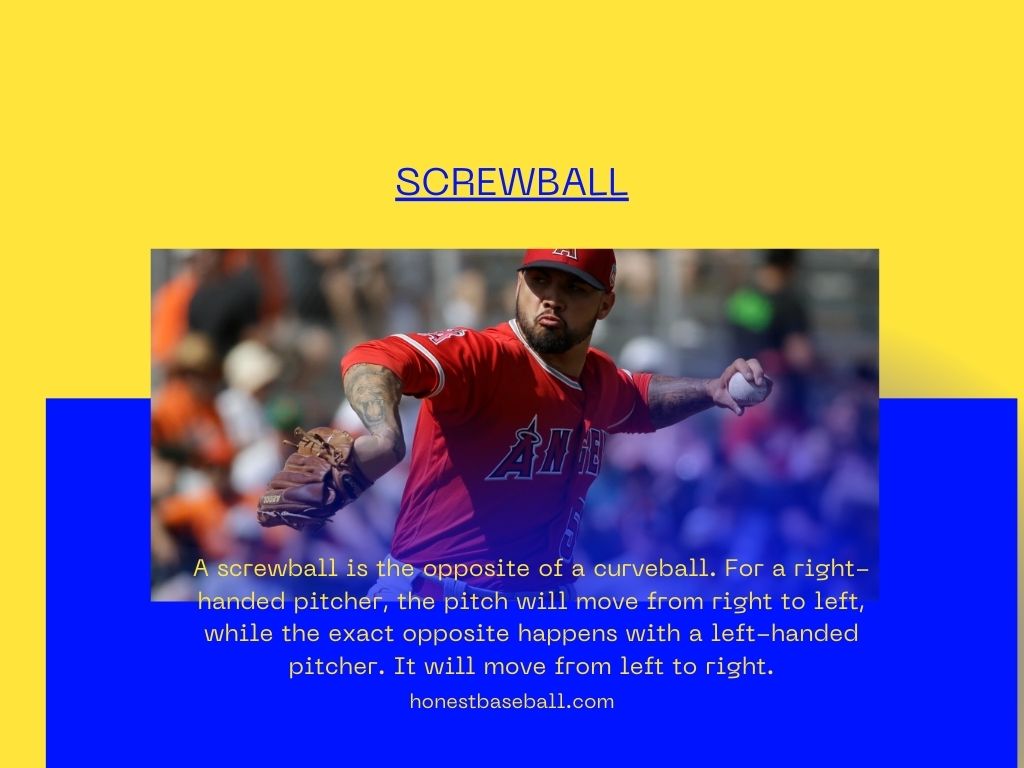
If I tell you a really simple way, a screwball is a late movement of the ball as you throw it. For a right-handed pitcher, the pitch will move from right to left, while the exact opposite happens with a left-handed pitcher. It will move from left to right.
The ball movement might not be as fast as you would expect, but the point of difference is that it can trick the batter.
Now how will you throw one?
Hold the ball with your index and middle fingers on the outside of the wide seams, similar to a two-seam fastball grip. Your thumb should be positioned underneath the ball, providing support and control.
Use a similar arm action to a fastball, keep your arm relaxed, and follow a consistent throwing motion.
When you release the ball, rotate your wrist and apply a little pressure with your index finger. This will create the unique movement of the screwball.
Try it out! It’s more fun doing it on your own.
Cutter Pitch
Do you want to throw a pitch that will make batters swing and miss or hit weakly? Then you need to learn how to throw a cutter.
It’s like a slider but with more speed. It’s a tricky pitch that moves slightly at the last moment, making it hard for batters to hit the ball solidly.
Hold the ball with your index and middle fingers a little off-center on the thin seams, with your thumb under the ball. Squeeze the ball with your middle finger to make it cut.
Throw it like a fastball, with the same arm action and windup. But when you let go of the ball, push down with your middle finger and snap your wrist down.
That will make the ball spin and move in the air. Finish your throw like a fastball, with good balance and control. And that’s how you throw a cutter that will frustrate any batter!
If you want to know more about this, I have a full article on what is a cutter pitch. Enjoy.
Wait! Need a practical demonstration on cutter pitch? Here’s a video of Mariano Rivera breaking the batter’s bat with the best cutter pitch of the century.
Palmball
Do you want to throw a pitch that will make batters swing and miss or hit weakly? Then you need to learn how to throw a cutter.
It’s like a slider but with more speed. It’s a tricky pitch that moves slightly at the last moment, making it hard for batters to hit the ball solidly.

Hold the ball with your index and middle fingers a little off-center on the thin seams, with your thumb under the ball. Squeeze the ball with your middle finger to make it cut.
Keep your arm action just like you do in the fastball. Relaxed! As you release, slowly relax the grip and let the ball roll off your fingers.
This will make the ball spin in the air and move sideways. And that’s how you throw a cutter that will frustrate any batter!
Forkball
If you’re looking to up your pitching game and really keep those batters guessing, why not give the forkball a try? It’s similar to a splitter but has even more drop, making it a tough pitch to hit. This nasty little number is sure to dive sharply as it approaches the plate.
To throw it properly, grip the ball with your index and middle fingers on either side of the ball, spread wide apart and positioned slightly deeper between the seams than a splitter. Use your thumb to support and control the ball.
When you’re ready to throw, treat it like a fastball with the same windup and arm action. Just remember to keep your fingers spread wide apart and snap your wrist down. This will give the ball the spin it needs to drop in the air.
Finally, finish your throw with good balance and control, just like a fastball. With this pitch in your arsenal, you’re sure to fool any batter!
Gyroball
A gyroball is a rare pitch that’s said to have a unique spin axis, resulting in a tight spiral movement. It’s not widely used, but some experts believe it can be a powerful weapon for pitchers.
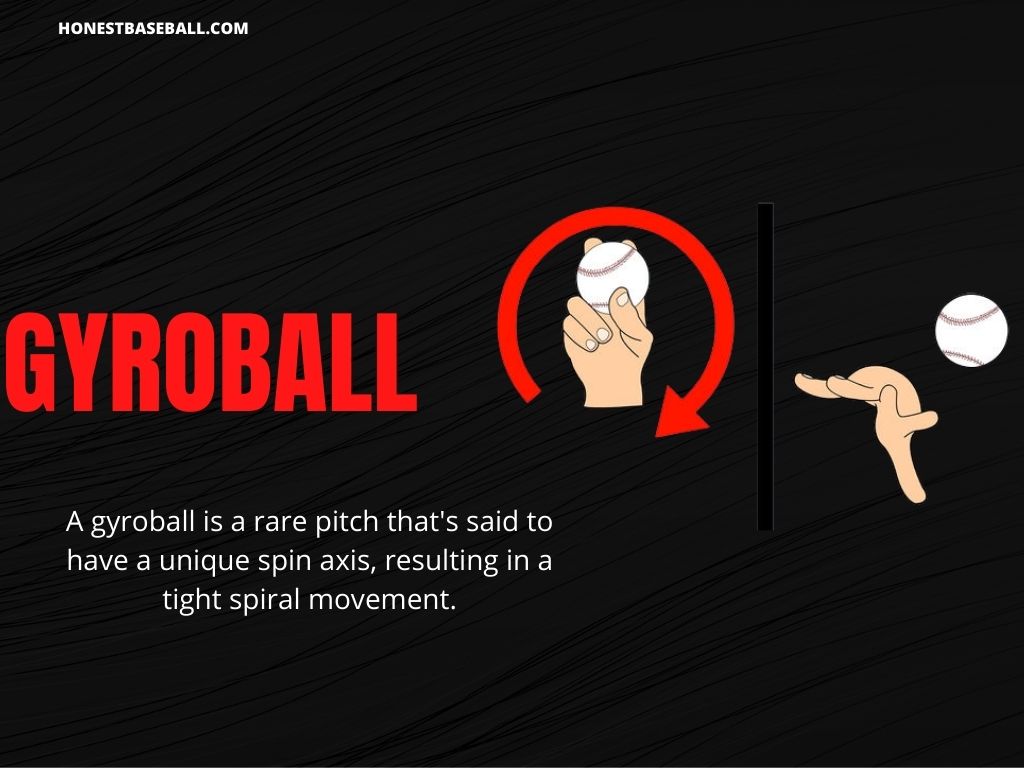
Just like a four-seam fastball. Place your thumb underneath the ball to provide support and control.
Don’t worry! This pitch is not that hard. You’ll need to use the same arm action as you would for a fastball. Keep your arm relaxed and consistent. Turn your wrist inward upon releasing. It will create the unique spin axis that makes the gyroball so distinctive.
You’ll see your pitch moves unpredictably. So why not give it a try and see if you can master this rare and exciting pitch? Remember to follow through with a balanced and controlled finish to make the most of your throw!
Eephus pitch
Want to make the batter’s jaw drop with your pitch? Try the Eephus pitch.
Some people call it “blooper” or “folly pitch,” because it’s so different from the usual fast and straight pitches.
It’s like a rainbow in the sky, curving up and then down toward the plate. The Eephus pitch is not your traditional fastball.
It tricks the batters off guard with its slow speed and unexpected movement.
Grip the ball gently with your middle and ring fingers resting on top of the seam. Your thumb will support the ball underneath.
Toss the ball gently with a loose wrist. Aim for a high arc. The trick is to keep the ball under control and make it soar high enough to puzzle the batter and make it hard to hit.
Slurve
Have you ever heard of a Slurve? It’s a wicked pitch that mixes the best of both worlds: a slider and a curveball.
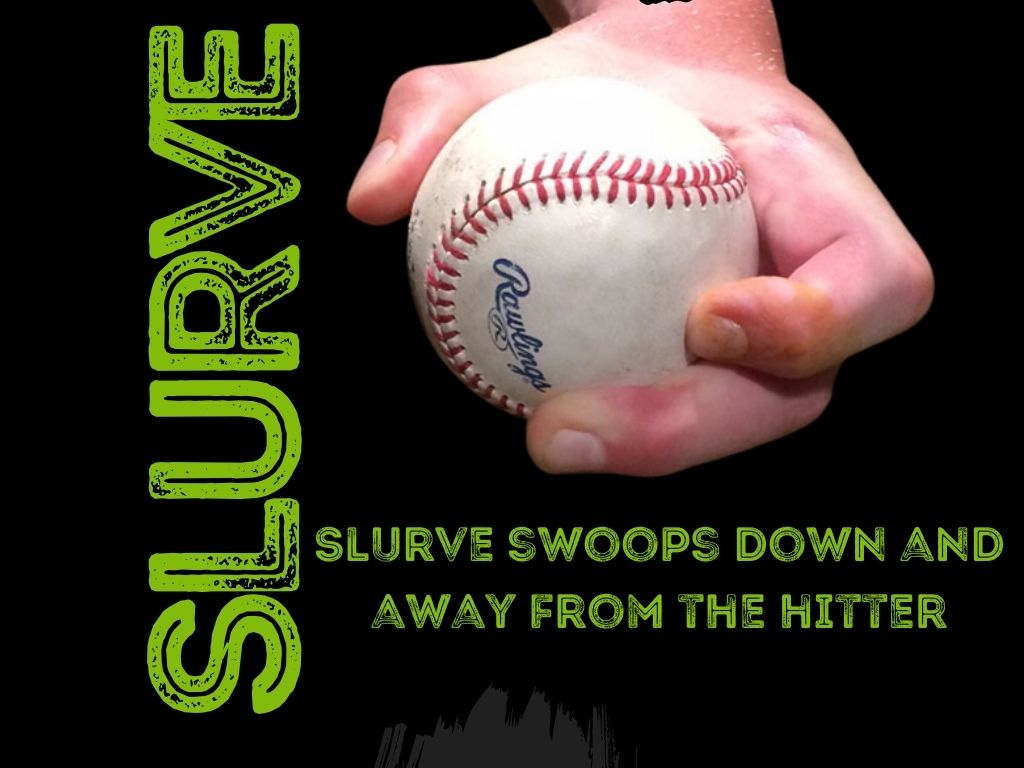
It swoops down and away from the hitter, making them look silly as they swing and miss. The Slurve is a great way to keep hitters off balance, especially if you also throw fastballs and other breaking balls.
Want to learn how to throw a Slurve?
It’s not too hard. Just start with a curveball grip, where your middle finger hugs the seam and your index finger rests next to it.
Then, as you let go of the ball, push down with your middle finger and twist your wrist a bit, like you’re opening a door. That’s how you get that awesome spin and break that makes the Slurve so special.
Spitball
Have you ever heard about this crazy, illegal pitch in baseball called the Spitball?
Back in the day, I mean like the early 1900s; pitchers used to put stuff like saliva or petroleum jelly on the ball to mess with its movement. It would make the ball fly all wonky and unpredictable, leaving batters scratching their heads!
But you know what? They banned the Spitball in 1920 because it just wasn’t safe. If you’re curious how it was thrown, pitchers will sneak some of that goopy stuff on the ball, usually near the seam.
Then you would hold the ball like a fastball, with the sticky spot facing away from the hitter. When you throw the ball, the sticky spot makes the air push and pull on the ball differently, making it move in unexpected ways that would fool the hitter and make them miss.
Knuckle-Curve Ball
Have you ever tried a Knuckle-Curve Ball? It’s this wild pitch that’s like a lovechild of a knuckleball and a curveball. It’s all about fooling the batter with its wacky movement, usually breaking down and away from them. It’s a total game-changer for pitchers who can nail the technique!
The Knuckle-Curve Ball is an excellent pitch for pitchers who can pull it off with its special release and spin. But how can you throw this one?
Hold the ball like you would for a curveball. Your middle finger goes on the seam, and your index finger is next to it. But the catch is instead of laying your index finger flat, bend it at the knuckle to touch the ball with just the tip.
Upon release, push down with your middle finger and flick your wrist downward. This makes the ball spin and breaks like no other pitch, making it hard to hit.
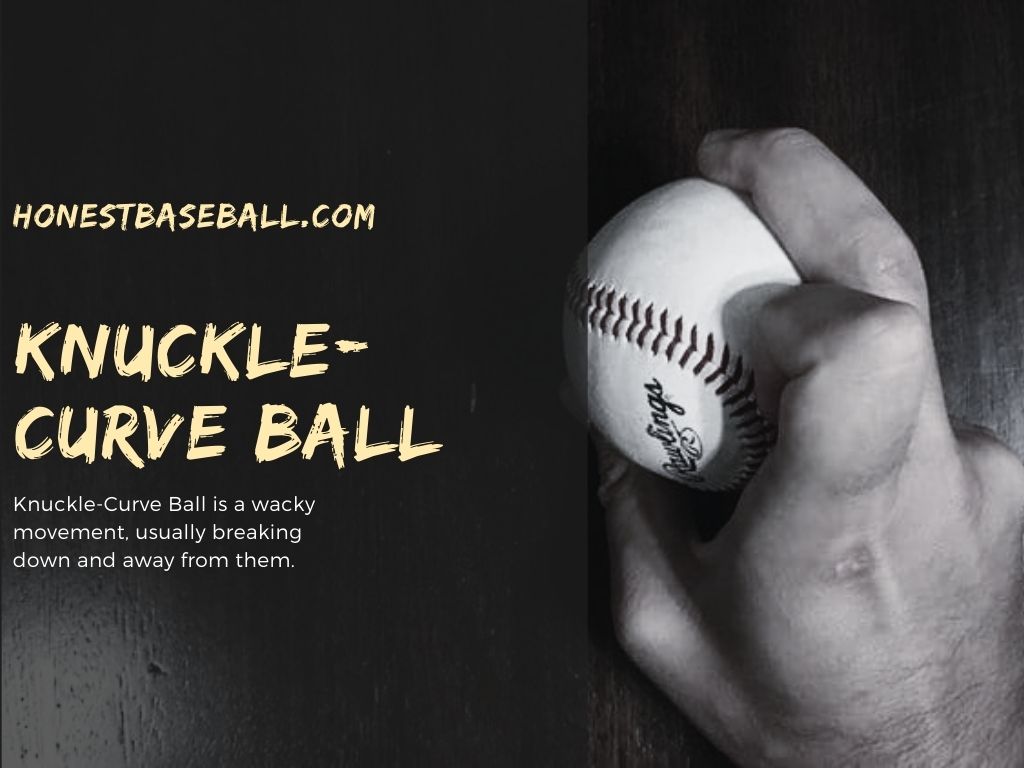
The trick to throwing a good Knuckle-Curve Ball is to keep your grip and release consistent so the pitch keeps moving in different ways and surprises batters. Once you’ve narrowed it down, you can mix it with your other pitches.
If you master the Knuckle-Curve Ball, be sure it will amp up your game on the mound!
You might be wondering, “How can I practice these pitches on my own?” Don’t worry, I’ve got you covered with my fantastic guide on “How to Start Practicing Pitching Alone” that’ll help you master those pitches in no time!
Frequently Asked Questions
1. What is the most effective pitch?
The greatest pitch isn’t necessarily the most flashy. The fastball is one of the most effective pitches I’ve ever seen. Simple but powerful!
2. How does a two-seam fastball differ from a four-seam fastball?
A two-seam fastball grips and moves differently from a four-seam fastball. The two-seam fastball boasts a greater lateral motion and sinks as it approaches the plate, making good contact more difficult for hitters.
3. What is the purpose of a changeup?
A changeup is an off-speed pitch used to fool batters with its slower velocity than a fastball. A changeup’s purpose is to throw off the batter’s timing, prompting them to swing too early and miss the ball or make poor contact.
4. What makes a curveball difficult to hit?
A curveball is a pitch that has a noticeable downward break as it approaches the plate. Because of the fast, late movement, hitters struggle to track and hit the ball firmly, resulting in swings and misses or poor contact.
5. How does a slider differ from a curveball?
A slider is a breaking ball pitch that moves lateral and downward. It is thrown faster than a curveball and has a more stringent, later break which can fool hitters, making it tough to hit.
6. What is unique about a knuckleball?
Knuckleball is a wayward pitch. It’s all about minimizing ball spin. It causes the ball to move about in the air as if it has its own consciousness! The knuckleball is unquestionably one of those speciality pitches that, when executed correctly, can be quite a success!
7. Why is a screwball considered a rare pitch?
A screwball is a pitch that travels in the reverse direction of a curveball, breaking downward and away from a hitter who is using the same hand as the pitcher. It is regarded as uncommon because of the peculiar arm action and grip necessary to efficiently throw it, which may be difficult to perfect and possibly taxing on the pitcher’s arm.
8. What is an eephus pitch?
A slow, high-arching fastball with a low velocity that is meant to catch the hitter off guard is known as an eephus pitch. The eephus pitch’s not expected and unusual character makes it difficult for hitters to timing their swing effectively.
9. How do pitchers choose which pitch to throw?
A lot goes into pitching. Pitchers must evaluate a variety of factors, including the batter’s weak places, the game’s current situation, and the pitcher’s finest pitch.
Catchers are super important in this process, too. They use their know-how and experience to figure out which pitches will really throw the batter off their game. It’s like a whole strategy within the game, and it’s amazing to watch it all unfold!
10. What is pitch sequencing?
Pitch sequencing is the strategic order in which a pitcher throws different pitch types to a batter. The goal is to keep the batter off-balance and to guess, making it more difficult for them to anticipate and hit the ball solidly.
11. Why is a cutter an effective pitch?
A cutter is a variation of a fastball with late, sharp lateral movement. This pitch makes it pretty hard for batters to square up the ball. It often results in weak contact or broken bats.
12. What is the difference between a circle changeup and a regular changeup?
The primary difference between a circle changeup and a regular changeup is the grip. A circle changeup is gripped with the index finger and thumb forming a circle on the side of the ball, resulting in slightly more movement and deception than a regular changeup.
13. What is a 12-6 curveball?
The 12-6 curveball is a fantastic pitch. It is called from how the hands of a clock go from 12 o’clock to 6 o’clock. This pitch is focused on the stunning vertical descent, with little lateral movement.
Ending Notes
You now have a solid understanding of baseball’s different types of pitches. The world of baseball pitches is vast and diverse. It offers you a thrilling experience as you explore the various types.
From the blazing fastball to the deceptive changeup, each pitch type serves a unique purpose, keeping both batters and spectators on their toes. As you delve deeper into the captivating art of pitching, remember to appreciate the skill and strategy involved in mastering these pitches.
So go ahead, grab a mitt and a ball, and start practicing these exciting pitch types with friends – who knows, you might just discover your inner baseball ace!
You May Also Like
Average Baseball Pitch Speed By Age
How To Increase Pitching Velocity By 10 MPH
How Many Pitchers Are On An MLB Team
10 Different Types Of Pitchers In Baseball

Hello everyone. My name is Jason Butler, and I live in California, America. I was a professional AAA Minor League Baseball player. I lost my chance of playing MLB for injury issues, but I did not lose my love for baseball. I attended the coaching training program and am now working as a coach in a small school in San Diego.
I always love to share my experience and knowledge if that can help you. Play baseball, and stay fit.
